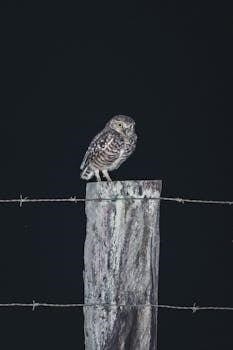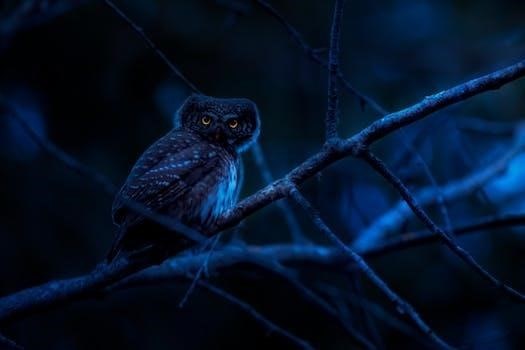
The Owl Who Was Afraid of the Dark⁚ An Analysis
Jill Tomlinson’s “The Owl Who Was Afraid of the Dark” is a beloved children’s story often available in PDF format. This accessibility allows for easy sharing and reading. The digital versions retain the charm of the original, making it a convenient option for educators and parents alike.
Plot Overview
The narrative centers around Plop, a baby barn owl who, unlike his peers, harbors a deep fear of the dark. This fear prevents him from joining his parents on their nightly hunts. The story unfolds as Plop’s mother encourages him to confront his fear by venturing out and discovering the true nature of the dark. Plop’s journey is structured into seven nights, each representing a different encounter and revelation about darkness. These encounters are designed to challenge his negative perceptions and expose him to the diverse aspects of the night. He meets various characters, including a little boy, an old lady, a scout, a girl, a man with a telescope, and a black cat. Through these interactions, Plop gains varied perspectives on the dark, learning that it can be kind, exciting, fun, necessary, and fascinating. Each night builds upon the previous, gradually dismantling his fear and replacing it with understanding and acceptance. Ultimately, Plop’s fear is transformed into curiosity and appreciation, enabling him to embrace the night and his role as a nocturnal hunter.
Plop’s Fear of the Dark
Plop’s fear of the dark is the central conflict driving the narrative. Unlike other barn owls who instinctively embrace the night, Plop is terrified of it. He perceives darkness as something inherently “nasty,” a sentiment that prevents him from engaging in typical owl activities, particularly hunting with his parents. This fear is not presented as a simple dislike but rather a profound anxiety that significantly impacts his life and development as a young owl. His fear is established early in the story, setting the stage for his journey of self-discovery and learning about the night. Plop’s reluctance to venture into the dark is a departure from the norm, making him an unusual character and highlighting his vulnerability. His fear manifests as a barrier to his natural instincts and family traditions, emphasizing the importance of overcoming personal anxieties. This fear is not criticized but acknowledged as a valid emotion, making Plop relatable to young readers who might also have their own fears.
Encounters and Discoveries about the Dark
Plop’s journey to understand the dark is marked by a series of significant encounters. He is sent by his mother to discover what the dark is really like. Each interaction offers a new perspective and challenges his initial perception of darkness as “nasty.” He meets diverse characters, including a little boy, an old lady, a scout, a girl, a man with a telescope, and a black cat, each providing unique insights. These characters share their experiences and feelings about the dark, revealing its multifaceted nature. The little boy waiting for fireworks finds the dark exciting, the old lady sees it as a time for reflection, the scout finds it adventurous, the girl associates it with the magic of Father Christmas, the man with the telescope views it with fascination, and the black cat embraces its explorative nature. Through these encounters, Plop learns that the dark is not a singular entity but a canvas for different experiences and emotions. These discoveries gradually shift his understanding and help him confront his fear.
Dark is Kind
One of the crucial lessons Plop learns is that the dark can be kind. This revelation comes from his encounter with an old lady who shares her perspective on the night. Unlike Plop’s initial belief that the dark is inherently “nasty,” she describes it as a comforting presence. She explains that in the dark, she can forget her age and reflect on fond memories, highlighting the peaceful and reflective nature of darkness. This encounter is pivotal in challenging Plop’s fear. He begins to understand that the dark isn’t something to be feared but a space for gentleness and tranquility. The old lady’s words offer a stark contrast to Plop’s anxieties, introducing him to the idea that darkness can be a source of solace and comfort. Her kindness and gentle explanation of the dark’s positive attributes mark a significant turning point in Plop’s journey. This understanding helps him to see the dark in a new light, shifting his perception from fear to acceptance, and that it can be more comforting than scary.

Dark is Exciting, Fun and Necessary
Plop’s journey to overcome his fear of the dark includes discovering that it can be exciting, fun, and necessary. He learns that the night is not just a time of scary shadows, but also a canvas for adventure and enjoyment. Through his encounters, he sees how other creatures thrive in the darkness, engaging in activities that are simply not possible during the day. This realization shifts his perspective from viewing the dark as a negative entity to understanding its vital role in the world; He witnesses fireworks illuminating the night sky, a scout camping under the stars, and a black cat exploring its surroundings. Each of these experiences highlights different aspects of the dark’s appeal. Furthermore, Plop learns that the dark is necessary for the natural world, it is the time when some animals are most active and thrive. These experiences collectively help Plop realize that the dark is not only not scary but also full of opportunity and wonder, essential for the cycle of life, and can be a source of joy.
Educational Themes
“The Owl Who Was Afraid of the Dark” offers several valuable educational themes, primarily centered around overcoming fears and embracing the unknown. The story subtly teaches children about different perspectives, encouraging them to understand that what might seem scary to one, may be enjoyable to another. Through Plop’s journey, children learn about the importance of questioning their fears and seeking knowledge rather than allowing fear to control them. The narrative also introduces basic scientific concepts related to nocturnal animals, their behaviors, and the necessity of darkness for certain species to thrive. The book encourages empathy by showing how Plop learns from various characters and their unique experiences with the dark, promoting understanding and acceptance of diverse viewpoints. Furthermore, the story touches on themes of bravery, adventure, and the natural world, providing excellent opportunities for discussions on emotions, family relationships, and nature itself. The narrative can act as a springboard for talking about personal fears and how to approach them in a constructive way. The tale is an effective tool for teaching children about emotional intelligence and curiosity.
Outdoor Learning Activities using the book

“The Owl Who Was Afraid of the Dark” can inspire several engaging outdoor learning activities. One activity involves a nighttime nature walk, where children can explore the sounds and sights of their surroundings in the dark, mimicking Plop’s experience. This walk encourages sensory exploration and discussions about nocturnal animals. A daytime activity could include creating a “dark den” using natural materials, allowing children to experience a simulated dark space and talk about their feelings associated with it. Another activity can center around a ‘who’s awake when’ exercise, where children investigate which animals are active during the day versus the night. This can be tied into the owl’s nocturnal lifestyle. Children can also create their own ‘dark’ discovery boxes or bags, using their senses to identify objects inside without seeing them. This activity can be linked to Plop’s interactions with different characters and their perspectives on the dark. Furthermore, storytelling sessions in a natural environment, using the book as a guide, can enhance the learning experience, followed by drawing or writing about their own encounters with the dark, fostering creativity and expression. These activities help children connect with nature and understand concepts from the book.
PDF Availability and Accessibility
The PDF format of “The Owl Who Was Afraid of the Dark” significantly enhances its accessibility for a wide range of users. This digital format allows for easy distribution and viewing on various devices, including computers, tablets, and smartphones. Many online platforms offer the book as a free PDF download, ensuring that the story is readily available for both educational and personal use. This accessibility is particularly beneficial for teachers who want to incorporate the story into their lessons, allowing them to easily share the book with their students. Additionally, the PDF format can be easily printed, enabling users to have a physical copy for reading sessions or for creating activity sheets. The digital format also supports features like text searching and zooming, which can be helpful for those with visual impairments or those needing to find a specific part of the story. The availability of the book in PDF ensures that it is accessible to individuals regardless of their geographical location or financial situation. The format also enables easy integration with other digital resources. This makes it a useful tool for both educators and families alike.
Characters and their perspectives about the dark
In “The Owl Who Was Afraid of the Dark,” the characters’ perspectives on the dark are central to Plop’s journey of overcoming his fear. Plop, the protagonist, initially views the dark as “nasty,” a source of discomfort and fear, leading him to avoid nighttime activities. Conversely, Mrs. Barn Owl, Plop’s mother, believes that owls should not be afraid of the dark, reflecting the traditional view of owls as nocturnal creatures. Throughout his exploration, Plop encounters various characters who each hold a unique perspective. An old lady sees the dark as kind, a time for reflection and good memories, while a young boy finds it exciting as he anticipates fireworks. A scout views the dark as a normal part of camping, and a girl associates it with Christmas magic and Father Christmas. A man with a telescope finds the dark fascinating and full of wonder, while a black cat sees the dark as a playground for exploration. These diverse viewpoints challenge Plop’s initial negative perception, encouraging him to reevaluate his own understanding and relationship with the dark. The variety of opinions provides a rich tapestry of ideas, which aids in Plop’s personal growth.








Leave a Reply
You must be logged in to post a comment.